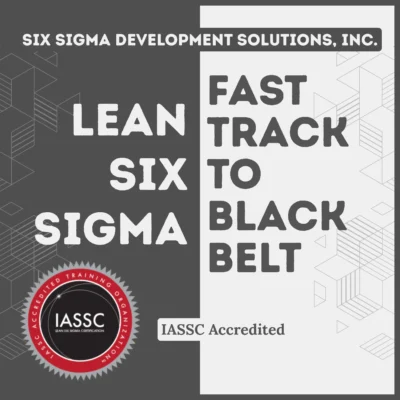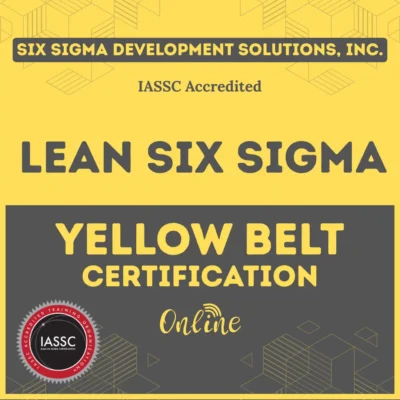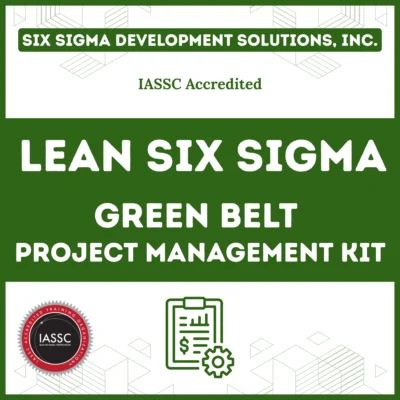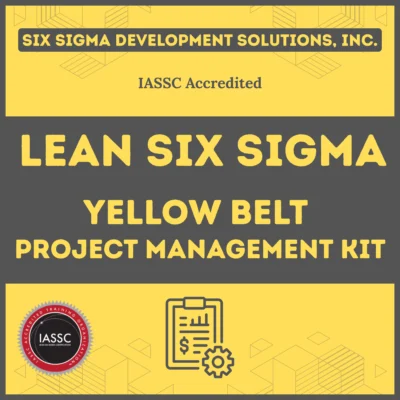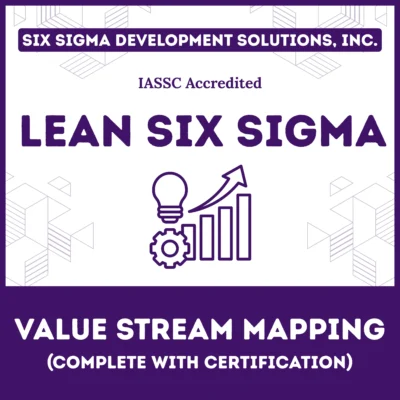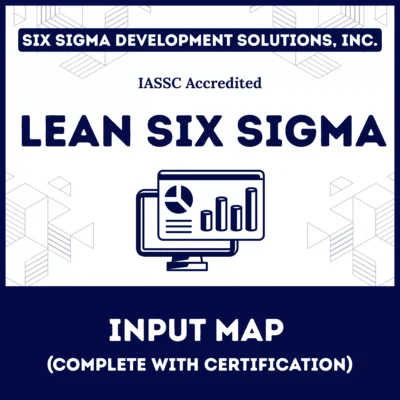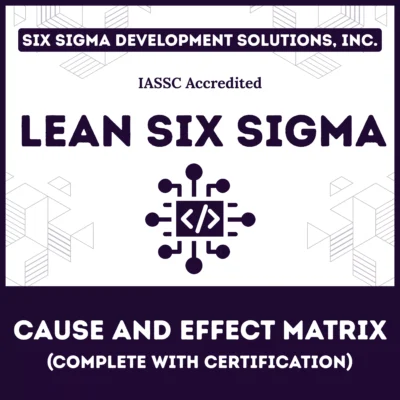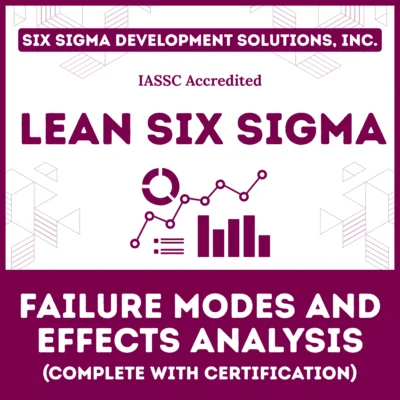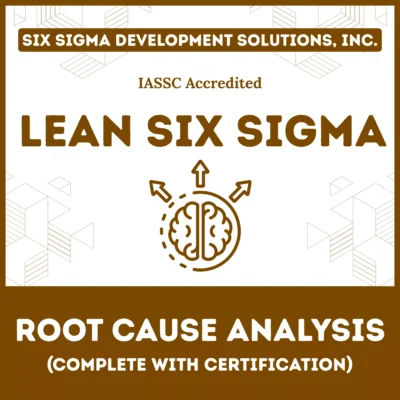Advanced product quality planning represents the foundation of successful product development and manufacturing excellence. Organizations that implement robust APQP processes consistently deliver higher quality products, reduce development costs, and achieve faster time-to-market.
This comprehensive guide explores how you can master advanced product quality planning to transform your product development capabilities.
Table of contents
What Is Advanced Product Quality Planning?
Advanced product quality planning (APQP) is a structured methodology that ensures product quality throughout the entire development lifecycle. This systematic approach integrates quality considerations from initial concept through production launch and ongoing manufacturing operations.
The APQP framework originated in the automotive industry but has expanded across manufacturing sectors as organizations recognize its value for preventing quality issues and reducing development risks. Companies use APQP to coordinate cross-functional teams, manage product requirements, and ensure manufacturing readiness.
APQP emphasizes prevention over detection by addressing potential quality issues during design and development phases. This proactive approach costs significantly less than correcting problems after production begins and helps maintain customer satisfaction and brand reputation.
Modern APQP implementations leverage digital tools, advanced analytics, and collaborative platforms to streamline processes and improve communication across global development teams. Technology integration enhances traditional APQP benefits while addressing contemporary business challenges.
Public, Onsite, Virtual, and Online Six Sigma Certification Training!
- We are accredited by the IASSC.
- Live Public Training at 52 Sites.
- Live Virtual Training.
- Onsite Training (at your organization).
- Interactive Online (self-paced) training,
The Five Phases of Advanced Product Quality Planning
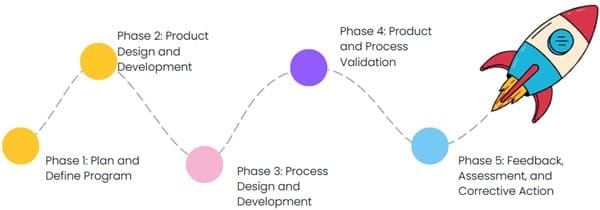
Phase 1: Plan and Define Program
The planning phase establishes the foundation for successful product development by defining program scope, objectives, and quality requirements. Teams create comprehensive project plans that align with customer expectations and organizational capabilities.
Cross-functional teams form during this phase, bringing together representatives from design, manufacturing, quality, purchasing, and other relevant departments. Clear role definitions and communication protocols ensure effective collaboration throughout the development process.
Customer requirements analysis drives program definition, translating market needs into specific product specifications and quality targets. This analysis includes voice of customer research, competitive benchmarking, and regulatory requirement assessment.
Risk assessment activities identify potential quality, schedule, and cost challenges early in the development process. Proactive risk identification enables teams to develop mitigation strategies and contingency plans before issues impact program success.
Phase 2: Product Design and Development
Design and development activities transform customer requirements into detailed product specifications and engineering drawings. This phase emphasizes design for quality, manufacturability, and cost optimization.
Design review processes ensure that product designs meet customer requirements while considering manufacturing constraints and quality objectives. Regular reviews enable early identification and resolution of design issues before they become costly problems.
Prototype development and testing validate design concepts and identify areas for improvement. Iterative prototyping allows teams to refine designs based on testing results and stakeholder feedback.
Design verification activities confirm that products meet specified requirements under various operating conditions. These activities include performance testing, durability assessment, and environmental testing protocols.
Phase 3: Process Design and Development
Process design activities create manufacturing methods that consistently produce products meeting quality specifications. This phase focuses on process capability, control, and optimization.
Manufacturing process development includes equipment selection, facility layout design, and production flow optimization. Teams consider factors like cycle times, capacity requirements, and quality control integration.
Process validation ensures that manufacturing processes can consistently produce products within specification limits. Statistical process control implementation helps maintain process stability and identify improvement opportunities.
Supplier development activities ensure that purchased components and materials meet quality requirements. Supplier quality assessments, capability studies, and performance monitoring support supply chain quality management.
Phase 4: Product and Process Validation
Validation activities demonstrate that products and processes meet all specified requirements under actual production conditions. This phase includes production trials, measurement system analysis, and process capability studies.
Production trial runs validate manufacturing processes using actual production equipment, tooling, and personnel. These trials identify potential issues and enable process refinement before full-scale production begins.
Measurement system analysis ensures that quality measurement tools and methods provide accurate, reliable data for process control and product verification. Proper measurement systems support effective quality management.
Process capability studies quantify manufacturing process performance and identify opportunities for improvement. Statistical analysis helps optimize process parameters and establish appropriate control limits.
Phase 5: Feedback, Assessment, and Corrective Action
The final phase focuses on continuous improvement through systematic feedback collection and analysis. This ongoing phase extends throughout the product lifecycle to maintain and enhance quality performance.
Customer feedback monitoring tracks product performance in actual use conditions and identifies areas for improvement. Systematic feedback collection enables proactive quality management and customer satisfaction enhancement.
Corrective action processes address quality issues and prevent recurrence through root cause analysis and systematic problem-solving. Effective corrective action systems minimize quality costs and improve customer experiences.
Lessons learned documentation captures knowledge from each program to improve future APQP implementations. Organizational learning accelerates development capabilities and reduces recurring quality issues.
Key APQP Tools and Techniques

Design Failure Mode and Effects Analysis (DFMEA)
DFMEA systematically identifies potential design failures and their impacts on product performance and customer satisfaction. This proactive analysis helps teams prioritize design improvements and prevent quality issues.
Design teams use DFMEA to evaluate failure modes, assess their severity and likelihood, and develop prevention strategies. Structured analysis ensures comprehensive consideration of potential design risks.
Risk priority numbers (RPNs) help teams focus improvement efforts on the most critical failure modes. Regular DFMEA updates throughout development maintain current risk assessments and improvement priorities.
DFMEA integration with design reviews and validation activities ensures that identified risks receive appropriate attention and resources for resolution.
Process Failure Mode and Effects Analysis (PFMEA)
PFMEA analyzes manufacturing processes to identify potential failure modes and their impacts on product quality. This analysis guides process design decisions and control strategy development.
Manufacturing teams use PFMEA to evaluate process risks, assess their potential impacts, and develop control measures. Systematic analysis ensures robust process design and appropriate quality controls.
Control plans developed from PFMEA analysis specify monitoring methods, inspection frequencies, and corrective action procedures. These plans provide operational guidance for maintaining process quality.
PFMEA linkage to process validation activities ensures that identified risks are properly addressed during process development and validation phases.
Control Plans
Control plans document the comprehensive approach for controlling processes and ensuring product quality. These living documents guide day-to-day manufacturing operations and quality management activities.
Effective control plans specify measurement methods, inspection frequencies, control limits, and corrective action procedures for each critical quality characteristic. Clear documentation ensures consistent quality management across shifts and operators.
Control plan development involves cross-functional teams to ensure comprehensive coverage of quality requirements and practical implementation considerations. Team involvement builds ownership and improves plan effectiveness.
Regular control plan updates maintain currency with process changes, customer requirement modifications, and continuous improvement initiatives. Dynamic control plans support ongoing quality management and improvement efforts.
Statistical Process Control (SPC)
SPC provides data-driven methods for monitoring and controlling manufacturing processes. Statistical tools help teams distinguish between normal process variation and special causes requiring corrective action.
Control charts track process performance over time and identify trends or patterns that indicate process changes. Real-time monitoring enables rapid response to quality issues and prevents defective product production.
Process capability analysis quantifies manufacturing process performance relative to specification requirements. Capability indices help teams assess process adequacy and identify improvement opportunities.
SPC integration with APQP phases ensures that statistical methods support quality planning, process development, and ongoing manufacturing operations.
Benefits of Implementing Advanced Product Quality Planning
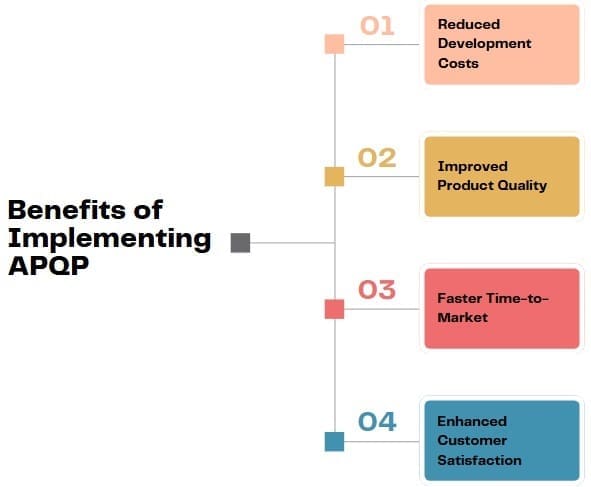
Reduced Development Costs
APQP implementation significantly reduces product development costs by preventing expensive design changes and manufacturing issues. Early problem identification and resolution cost far less than correcting issues after production begins.
Structured planning and cross-functional collaboration minimize rework and development delays. Coordinated team efforts reduce duplicated work and improve resource utilization throughout development programs.
Supplier integration through APQP reduces supply chain quality issues and associated costs. Proactive supplier development prevents quality problems that could disrupt production schedules and increase costs.
Risk mitigation strategies developed during APQP planning reduce the likelihood of costly quality failures and warranty claims. Prevention-focused approaches provide better return on investment than reactive quality management.
Improved Product Quality
APQP emphasizes quality throughout the development process, resulting in products that consistently meet customer expectations and regulatory requirements. Systematic quality planning prevents defects and enhances customer satisfaction.
Design optimization through APQP tools like DFMEA and design reviews improves product reliability and performance. Better designs reduce field failures and enhance brand reputation.
Process optimization ensures manufacturing consistency and reduces product variability. Capable processes produce products within specification limits and minimize quality-related customer complaints.
Continuous improvement integrated into APQP processes drives ongoing quality enhancement throughout product lifecycles. Systematic improvement efforts maintain competitive quality advantages.
Faster Time-to-Market
Structured APQP processes accelerate product development by providing clear milestones, deliverables, and decision points. Organized development approaches prevent delays and enable faster program completion.
Early identification and resolution of quality issues prevent late-stage delays that could impact launch schedules. Proactive problem-solving maintains development momentum and schedule adherence.
Cross-functional collaboration facilitated by APQP improves communication and reduces coordination delays. Effective teamwork accelerates development activities and enables parallel work streams.
Supplier readiness ensured through APQP processes prevents supply chain delays that could impact product launches. Coordinated supplier development supports schedule achievement and quality objectives.
Enhanced Customer Satisfaction
APQP ensures that customer requirements drive product development decisions and quality planning activities. Customer-focused development approaches result in products that better meet market needs and expectations.
Quality products delivered through APQP implementation enhance customer experiences and build brand loyalty. Consistent quality performance supports customer retention and positive word-of-mouth marketing.
Reduced field failures and warranty issues improve customer confidence and reduce total cost of ownership. Reliable products enhance customer satisfaction and competitive positioning.
Faster response to customer feedback through APQP continuous improvement processes demonstrates commitment to customer success and drives ongoing relationship development.
Industries Utilizing Advanced Product Quality Planning
Automotive Manufacturing
The automotive industry pioneered APQP development and continues to drive innovation in quality planning methodologies. Automotive manufacturers use APQP to manage complex product development programs involving multiple suppliers and global manufacturing operations.
Automotive APQP implementation includes specific tools like production part approval processes (PPAP) and supplier quality management systems. These industry-specific adaptations address unique automotive quality requirements and supply chain complexity.
Electric vehicle development programs increasingly rely on APQP to manage new technology integration and ensure battery safety and performance. APQP adaptations address emerging automotive technologies and regulatory requirements.
Global automotive supply chains leverage APQP for coordinating quality requirements across multiple tiers of suppliers and manufacturing locations. Standardized APQP processes enable consistent quality management worldwide.
Aerospace and Defense
Aerospace companies use APQP to manage complex product development programs with stringent safety and reliability requirements. APQP adaptations address unique aerospace quality standards and regulatory compliance needs.
Defense contractors implement APQP to ensure product quality while meeting tight schedule and budget constraints. Government contract requirements often mandate specific quality planning and documentation standards.
Commercial aviation programs use APQP to coordinate development activities across global supply chains and ensure regulatory compliance. International certification requirements drive comprehensive quality planning approaches.
Space exploration programs leverage APQP for managing mission-critical product development where failure is not an option. Extreme reliability requirements necessitate rigorous quality planning and validation processes.
Medical Device Manufacturing
Medical device companies implement APQP to ensure product safety and regulatory compliance while managing complex development programs. FDA and international regulatory requirements drive comprehensive quality planning approaches.
Life-critical medical devices require extensive APQP implementation to ensure patient safety and product efficacy. Risk management integration with APQP addresses unique medical device quality challenges.
Implantable device development programs use APQP to manage biocompatibility requirements and long-term performance validation. Extended product lifecycles require comprehensive quality planning and ongoing monitoring.
Digital health technologies increasingly rely on APQP for managing software quality and cybersecurity requirements. Evolving regulatory landscapes drive APQP adaptations for digital medical devices.
Electronics and Technology
Electronics manufacturers use APQP to manage rapid product development cycles and evolving technology requirements. Fast-paced markets require agile APQP implementations that balance speed with quality.
Consumer electronics companies implement APQP to ensure product reliability while meeting aggressive cost and schedule targets. Market competitiveness drives efficient quality planning processes.
Semiconductor manufacturers leverage APQP for managing complex manufacturing processes and ensuring product performance. High-volume production requirements necessitate robust quality planning and control systems.
Technology companies use APQP for managing software development quality and system integration challenges. Digital product development requires APQP adaptations for software quality management.
Implementing Advanced Product Quality Planning
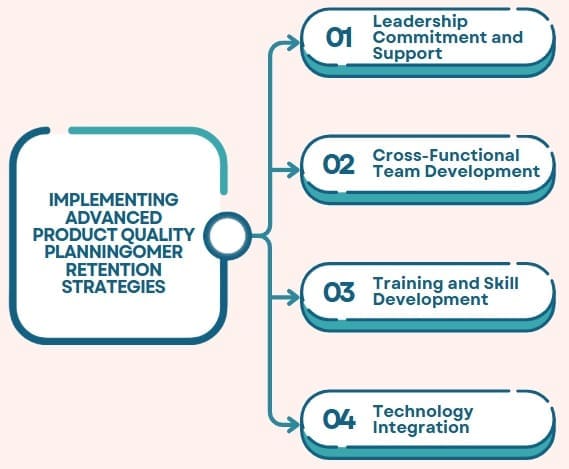
Leadership Commitment and Support
Successful APQP implementation requires strong leadership commitment and visible support throughout the organization. Leaders must champion quality planning principles and provide necessary resources for effective implementation.
Executive sponsorship ensures that APQP receives appropriate priority and resources during competing demands for organizational attention. Leadership commitment drives cultural change and employee engagement.
Quality leadership development programs help managers understand APQP principles and their role in successful implementation. Educated leaders make better decisions and provide more effective support for quality initiatives.
Performance measurement systems that include APQP metrics encourage leadership attention and continuous improvement. What gets measured gets managed, and APQP metrics drive organizational focus.
Cross-Functional Team Development
APQP success depends on effective cross-functional teams that bring together diverse expertise and perspectives. Team development activities build collaboration skills and shared understanding of quality objectives.
Team charter development clarifies roles, responsibilities, and expectations for APQP team members. Clear expectations prevent confusion and ensure effective team performance.
Communication protocols and meeting structures facilitate effective collaboration across different departments and geographic locations. Good communication enables successful APQP implementation.
Conflict resolution processes help teams address disagreements and maintain productive working relationships. Healthy conflict management prevents issues from derailing APQP programs.
Training and Skill Development
Comprehensive training programs ensure that employees understand APQP principles, tools, and techniques. Effective training builds capability and confidence for successful implementation.
Role-specific training addresses different APQP responsibilities and provides targeted skill development. Customized training improves relevance and effectiveness for different employee groups.
Hands-on training using real projects and case studies builds practical skills and experience. Applied learning approaches improve knowledge retention and application.
Continuous learning programs keep employees current with evolving APQP best practices and emerging quality management techniques. Ongoing education maintains organizational capability and competitive advantage.
Technology Integration
Modern APQP implementations leverage technology platforms for document management, collaboration, and data analysis. Technology integration improves efficiency and enables better decision-making.
Cloud-based platforms enable global teams to collaborate effectively on APQP activities and share information in real-time. Digital collaboration tools support distributed development teams.
Data analytics capabilities help teams identify trends, patterns, and improvement opportunities in APQP data. Advanced analytics enhance traditional quality planning approaches.
Integration with enterprise systems ensures that APQP data flows seamlessly with other business processes and systems. System integration improves data accuracy and reduces manual effort.
Measuring APQP Success
Key Performance Indicators
Effective APQP measurement requires carefully selected key performance indicators that reflect program success and organizational objectives. Balanced scorecards provide comprehensive performance assessment.
Quality metrics like defect rates, customer complaints, and warranty costs indicate APQP effectiveness in preventing quality issues. Quality performance measures demonstrate program value and impact.
Schedule and cost metrics track development program performance and identify opportunities for improvement. Integrated metrics show the relationship between quality planning and business outcomes.
Customer satisfaction metrics measure the ultimate impact of APQP on customer experiences and market success. Customer-focused metrics validate APQP value and guide improvement efforts.
Continuous Improvement Integration
APQP measurement systems should drive continuous improvement through systematic data analysis and action planning. Measurement without improvement wastes resources and misses opportunities.
Regular program reviews analyze APQP performance data and identify improvement opportunities. Structured reviews ensure that measurement data drives meaningful action.
Best practice sharing across programs and organizations accelerates improvement and prevents recurring issues. Knowledge management systems capture and disseminate APQP lessons learned.
Benchmarking against industry standards and competitors provides context for APQP performance and identifies improvement targets. External benchmarking drives competitive advantage.
Return on Investment Analysis
APQP investment justification requires clear demonstration of return on investment through cost savings, quality improvements, and revenue enhancement. Business case development supports continued APQP investment.
Cost avoidance calculations quantify the value of preventing quality issues through effective APQP implementation. Prevention costs significantly less than correction after problems occur.
Revenue impact analysis shows how APQP contributes to customer satisfaction, market share, and business growth. Quality reputation drives business success and competitive advantage.
Total cost of quality analysis provides comprehensive assessment of APQP value by considering all quality-related costs and benefits. Holistic analysis supports strategic decision-making.
Frequently Asked Questions
What are the five phases of Advanced Product Quality Planning?
The five APQP phases are: 1) Plan and Define Program, 2) Product Design and Development, 3) Process Design and Development, 4) Product and Process Validation, and 5) Feedback, Assessment, and Corrective Action.
How does APQP differ from traditional quality management?
APQP integrates quality planning throughout the entire product development lifecycle, emphasizing prevention over detection. Traditional quality management often focuses on inspection and correction after problems occur, while APQP prevents issues through systematic planning.
What industries benefit most from APQP implementation?
While APQP originated in automotive manufacturing, it benefits any industry with complex product development requirements. Aerospace, medical devices, electronics, and manufacturing industries extensively use APQP for quality assurance.
How long does APQP implementation typically take?
APQP implementation timeframes vary based on product complexity and organizational readiness. Simple products may complete APQP in 6-12 months, while complex products can require 2-3 years for full implementation.
What are the most important APQP tools?
Key APQP tools include Design FMEA (DFMEA), Process FMEA (PFMEA), Control Plans, and Statistical Process Control (SPC). These tools provide systematic approaches for risk assessment, process control, and quality management.
How do you measure APQP success?
Measure APQP success through quality metrics (defect rates, customer complaints), schedule performance (time-to-market), cost metrics (development costs, warranty expenses), and customer satisfaction scores.
Can APQP be used for service development?
Yes, APQP principles apply to service development by focusing on service quality planning, process design, and customer satisfaction. Service APQP adaptations address unique service delivery challenges and requirements.
What role does supplier management play in APQP?
Supplier management is critical to APQP success, ensuring that purchased components meet quality requirements. Supplier development, capability assessment, and performance monitoring support overall APQP objectives and supply chain quality.
Final Words
Advanced Product Quality Planning (APQP) is a structured, proactive approach to product and process design that ensures customer expectations are met from concept through production. By emphasizing early planning, cross-functional collaboration, and risk mitigation, APQP helps organizations prevent defects, reduce time to market, and improve product reliability.
When implemented effectively, it enhances communication between teams, aligns product development with customer needs, and supports compliance with industry standards—especially in sectors like automotive and aerospace. Embracing APQP not only drives continuous improvement but also builds a foundation for long-term customer satisfaction and competitive success.




